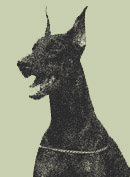|
History of Cropped Ears and Docked Tails
Dobermans from the days of the breed creation had their tails docked and their ear cropped.
In Germany 100 years ago dog owners had to pay taxes on their dog, unless the dogs were "working dogs".
One can distinguish a working dog by its docked tail.
Louis Dobermann was trying to create a working dog and since the early days of the breed,
Dobermans had their tails docked. Many of the dogs of that time were born without a tail. During WWII a lot of Dobermans
were lost and the bob-tailed gene has disappeared from the modern bloodlines.
Louis Dobermann wanted to create a dog that looked very alert. So he decided to crop the ears to achieve that look.
Nowadays some countries in Europe do not allowed cropped ears and docked tails. But Poland, Serbia, Austria, France,
Greece, Romania, Switzerland, Slovakia, Russia, Moldavia, Ukraine & the Baltic do show cropped/docked Dobermans.
Here in America we do show Dobermans with their ears cropped, tailed docked and dewclaws removed.
If you buy a puppy from European Legacy, we can have his ears cropped for an additional $250.
Should you decide to take your puppy to your local vet and have his ears cropped upon arrival, then take our advice, choose your vet carefully.
Do your homework, find a vet who is experienced in cropping Doberman ears, if possible ask to see pictures of the vets previous Doberman crops.
We recommend you to have the ears cropped at 8-10 weeks. If the crop is performed after 12 weeks,
the ears may take a long time (up to a year) to stand up and sometimes they won’t stand at all!
The cropped ears will require your patience and consistency. It is not difficult to tape ears, but you have to continue taping until they REALLY stand.
When you unwrap them after 5-6 days to renew the wrap, don't leave them unwrapped for more than 20 minutes or so. Immediately wrap them again.
After a couple of months you can see if they stand, at the FIRST sign that they may come down, wrap them again. How long do you need to tape?
It really depends on the dog, the type of ears he has, and the ear-crop (there are short, medium and long types of ear-crops). More than likely it will take you 2
to 4 months of taping.
Never tape or post infected ears. Also remember to clean the ears from glue after removing the tape with Peroxide or Rubbing Alcohol.
You can start wrapping only after the edges are healed,
and there are no scabs anywhere on the edges. You will have to care for the edges, by applying neosporin
and rubbing it gently to soften the scabs. In a few days after cropping you will be ready to
wrap the ears.
There are several methods of taping or posting the ears. Here I would like to describe one of them.
I have used 2 other methods of “no tape ear taping method” and “spiral taping” method.
I would like to warn you that one needs to be careful that the ears would stand symmetrically and in the right position to the head.
If you see that one ear is falling inwards or forward, you need to take the steps to correct the problem.
The method below was shown to me by my veterinarian Dr. Soltero of Scottsdale Arizona and it really did help me to correct the ear-position,
when one of Feliss ears was falling inwards. I highly recommend it. Just make sure to intervene in a timely matter if you have a problem,
as if you wait too long the ear(s) may never stand right.
| 




